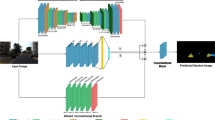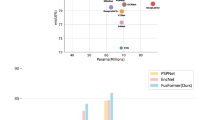Abstract
Small object segmentation is important due to its vast application potential for biomedical and surveillance. This paper describes several ensemble methods that combine different fully convolutional neural networks (FCNNs) for accurate semantic segmentation of aerial images. One problem with a single model for accurate small object segmentation is that the small object classes are suppressed by large object classes, which can increase overfitting problems and hinder generalization performance. Furthermore, using the single model for segmentation has particular strengths and weaknesses, and the segmentation accuracy changes with the different features used for training. Thus, this paper describes several ensemble methods that combine multiple fully convolutional networks for accurate semantic segmentation of unmanned aerial vehicles (UAVs) images. The proposed method starts with performing object localization for each single FCNN model. After that, each model’s channels of feature map outputs are combined to guide the training of the ensemble segmentation network. We have performed experiments on UAVid benchmark dataset. The results show that the proposed ensemble approach outperforms the single model that directly uses the channels of the single model’s feature map outputs.
Access this chapter
Tax calculation will be finalised at checkout
Purchases are for personal use only
Similar content being viewed by others
References
Abdullah, A., Ting, W.E.: Orientation and scale based weights initialization scheme for deep convolutional neural networks. Asia-Pac. J. Inf. Technol. Multimed. 9, 103–112 (2020)
Albashish, D.: Ensemble of adapted convolutional neural networks (CNN) methods for classifying colon histopathological images. PeerJ Comput. Sci. 8, e1031 (2022)
Albashish, D., Al-Sayyed, R.M.H., Abdullah, A., Ryalat, M.H., Almansour, N.A.: Deep CNN model based on VGG16 for breast cancer classification. In: 2021 International Conference on Information Technology (ICIT), pp. 805–810 (2021)
Brown, G., Wyatt, J.L., Harris, R., Yao, X.: Diversity creation methods: a survey and categorisation. Inf. Fusion 6, 5–20 (2005)
Corinna Cortes and Vladimir Naumovich Vapnik: Support-vector networks. Mach. Learn. 20, 273–297 (2004)
Dalal, N., Triggs, B.: Histograms of oriented gradients for human detection. In: 2005 IEEE Computer Society Conference on Computer Vision and Pattern Recognition (CVPR 2005), vol. 1, pp. 886–893 (2005)
Dong, R., Pan, X., Li, F.: DenseU-net-based semantic segmentation of small objects in urban remote sensing images. IEEE Access 7, 65347–65356 (2019)
Dong, Y., Du, B., Zhang, L.P.: Target detection based on random forest metric learning. IEEE J. Sel. Top. Appl. Earth Observ. Remote Sens. 8, 1830–1838 (2015)
Ibrahim, Z., Diah, N.M., Azmi, M.E., Abdullah, A., Zin, N.A.M.: Real-time mobile application for handwritten digit recognition using MobileNet. In: Mahyuddin, N.M., Mat Noor, N.R., Mat Sakim, H.A. (eds.) Proceedings of the 11th International Conference on Robotics, Vision, Signal Processing and Power Applications. LNEE, vol. 829, pp. 1003–1008. Springer, Singapore (2022). https://doi.org/10.1007/978-981-16-8129-5_153
Inglada, J.: Automatic recognition of man-made objects in high resolution optical remote sensing images by SVM classification of geometric image features. ISPRS J. Photogramm. Remote. Sens. 62, 236–248 (2007)
Kisantal, M., Wojna, Z., Murawski, J., Naruniec, J., Cho, K.: Augmentation for small object detection. ArXiv, abs/1902.07296 (2019)
Li, M., Zang, S., Zhang, B., Li, S., Changshan, W.: A review of remote sensing image classification techniques: the role of spatio-contextual information. Eur. J. Remote Sens. 47, 389–411 (2014)
Lin, T.-Y., Dollár, P., Girshick, R.B., He, K., Hariharan, B., Belongie, S.J.: Feature pyramid networks for object detection. In: 2017 IEEE Conference on Computer Vision and Pattern Recognition (CVPR), pp. 936–944 (2017)
Noh, H., Hong, S., Han, B.: Learning deconvolution network for semantic segmentation. In: 2015 IEEE International Conference on Computer Vision (ICCV), pp. 1520–1528 (2015)
Ojala, T., Pietikäinen, M., Mäenpää, T.: Multiresolution gray-scale and rotation invariant texture classification with local binary patterns. IEEE Trans. Pattern Anal. Mach. Intell. 24, 971–987 (2002)
Ozer, S., et al.: Supervised and unsupervised methods for prostate cancer segmentation with multispectral MRI. Med. phys. 37(4), 1873–83 (2010)
Pires, C., Damas, B.D., Bernardino, A.: An efficient cascaded model for ship segmentation in aerial images. IEEE Access 10, 31942–31954 (2022)
Ronneberger, O., Fischer, P., Brox, T.: U-net: convolutional networks for biomedical image segmentation. ArXiv, abs/1505.04597 (2015)
Shelhamer, E., Long, J., Darrell, T.: Fully convolutional networks for semantic segmentation. In: 2015 IEEE Conference on Computer Vision and Pattern Recognition (CVPR), pp. 3431–3440 (2015)
Siswantoro, J., Prabuwono, A.S., Abdullah, A., bin Idrus, B.: Automatic image segmentation using sobel operator and k-means clustering: a case study in volume measurement system for food products. In: 2015 International Conference on Science in Information Technology (ICSITech), pp. 13–18 (2015)
Tan, M., Le, Q.V.: EfficientNet: rethinking model scaling for convolutional neural networks. ArXiv, abs/1905.11946 (2019)
Trémeau, A., Borel, N.: A region growing and merging algorithm to color segmentation. Pattern Recognit. 30, 1191–1203 (1997)
Viola, P.A., Jones, M.J.: Rapid object detection using a boosted cascade of simple features. In: Proceedings of the 2001 IEEE Computer Society Conference on Computer Vision and Pattern Recognition, CVPR 2001, vol. 1, p. I (2001)
Wu, G., et al.: A stacked fully convolutional networks with feature alignment framework for multi-label land-cover segmentation. Remote. Sens. 11, 1051 (2019)
Wu, G., et al.: Automatic building segmentation of aerial imagery using multi-constraint fully convolutional networks. Remote. Sens. 10, 407 (2018)
Mushrif, M.M., Dubey, Y.K.: FCM clustering algorithms for segmentation of brain MR images. Adv. Fuzzy Syst. 2016, 1–14 (2016)
Zhang, Z.V., Tang, M., Cobzas, D., Zonoobi, D., Jägersand, M., Jaremko, J.L.: End-to-end detection-segmentation network with ROI convolution. In: 2018 IEEE 15th International Symposium on Biomedical Imaging (ISBI 2018), pp. 1509–1512 (2018)
Acknowledgment
This work has been supported by the University Kebangsaan Malaysia Research Grant GUP, GUP-2021-063 and Malaysia’s Ministry of Higher Education Fundamental Research Grant FRGS/1/2019/ICT02/UKM/02/8.
Author information
Authors and Affiliations
Corresponding author
Editor information
Editors and Affiliations
Rights and permissions
Copyright information
© 2023 The Author(s), under exclusive license to Springer Nature Switzerland AG
About this paper
Cite this paper
Lam, K.L., Abdullah, A., Albashish, D. (2023). Ensemble of Fully Convolutional Neural Networks with End-to-End Learning for Small Object Semantic Segmentation. In: Jo, J., et al. Robot Intelligence Technology and Applications 7. RiTA 2022. Lecture Notes in Networks and Systems, vol 642. Springer, Cham. https://doi.org/10.1007/978-3-031-26889-2_12
Download citation
DOI: https://doi.org/10.1007/978-3-031-26889-2_12
Published:
Publisher Name: Springer, Cham
Print ISBN: 978-3-031-26888-5
Online ISBN: 978-3-031-26889-2
eBook Packages: Intelligent Technologies and RoboticsIntelligent Technologies and Robotics (R0)




